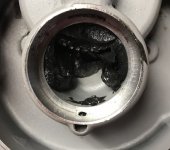anchorman
Titanium
- Joined
- Dec 19, 2005
- Location
- Opelika, AL
I'm fixing a part for a saw that is no longer made, and have come against a small problem...
The main bearing had spun around in the bore in the casting, and wallowed it out, so I bored it larger, installed an aluminum sleeve with loctite 609, and then bored the sleeve to the proper size. My bearing now fits and seems concentric enough for the job. In going over the parts diagram to make sure I wasn't missing anything, I came across a part labeled "ball bearing slug", and realized that perhaps this missing part is why the bore in the housing got so sloppy in the first place.
The existing bearing is well attached to the armature of the motor, and is not making noise or seeming to have excessive play, so I wasn't going to try to pull it off and damage it in the process. The problem here is that it looks like the bearing is actually meant to be put in the housing first, since I can't see any other way to put this slug in place to keep the outer race of the bearing from spinning. I've never seen a bearing installed in this manner, and cursory googling found only other milwaukee tools put together this way.
I'm wondering if anyone has thoughts as to whether this slug is indeed meant to prevent the outer race from spinning, and whether I could get around using one by installing a small set screw through the housing to hold the bearing in place. Or maybe this part can be ignored? Please see attached pictures for details.
Thanks in advance,
jon
The main bearing had spun around in the bore in the casting, and wallowed it out, so I bored it larger, installed an aluminum sleeve with loctite 609, and then bored the sleeve to the proper size. My bearing now fits and seems concentric enough for the job. In going over the parts diagram to make sure I wasn't missing anything, I came across a part labeled "ball bearing slug", and realized that perhaps this missing part is why the bore in the housing got so sloppy in the first place.
The existing bearing is well attached to the armature of the motor, and is not making noise or seeming to have excessive play, so I wasn't going to try to pull it off and damage it in the process. The problem here is that it looks like the bearing is actually meant to be put in the housing first, since I can't see any other way to put this slug in place to keep the outer race of the bearing from spinning. I've never seen a bearing installed in this manner, and cursory googling found only other milwaukee tools put together this way.
I'm wondering if anyone has thoughts as to whether this slug is indeed meant to prevent the outer race from spinning, and whether I could get around using one by installing a small set screw through the housing to hold the bearing in place. Or maybe this part can be ignored? Please see attached pictures for details.
Thanks in advance,
jon




